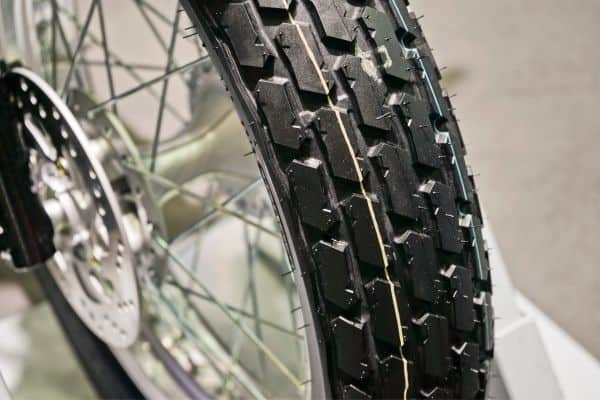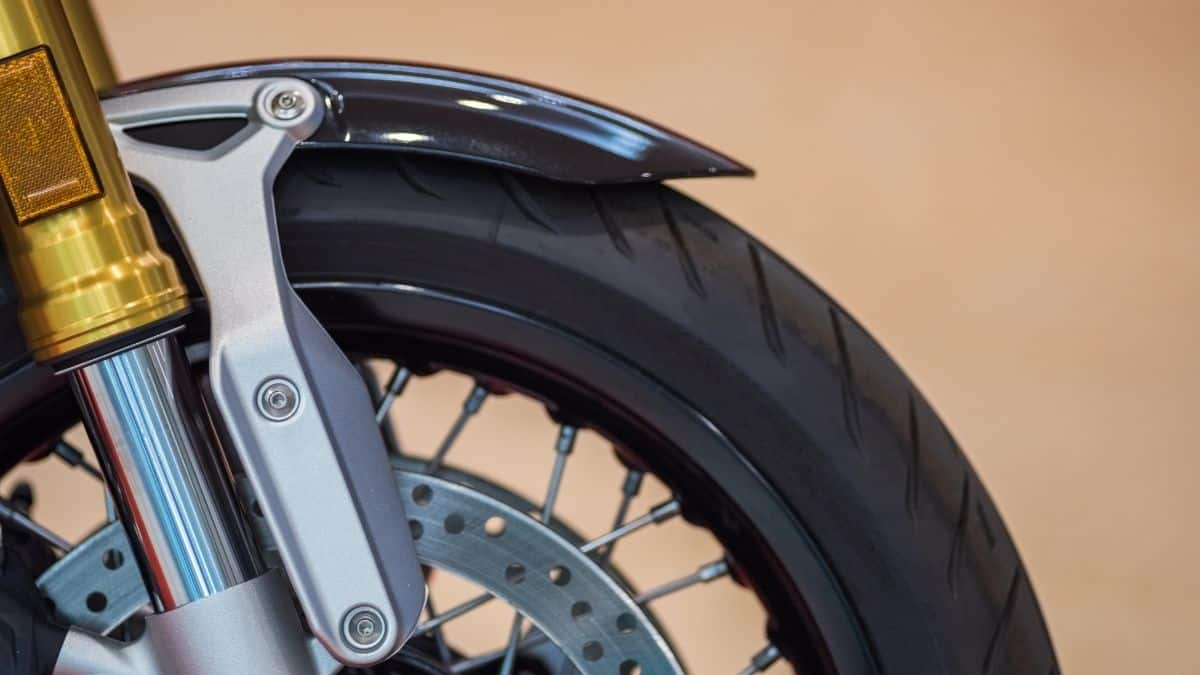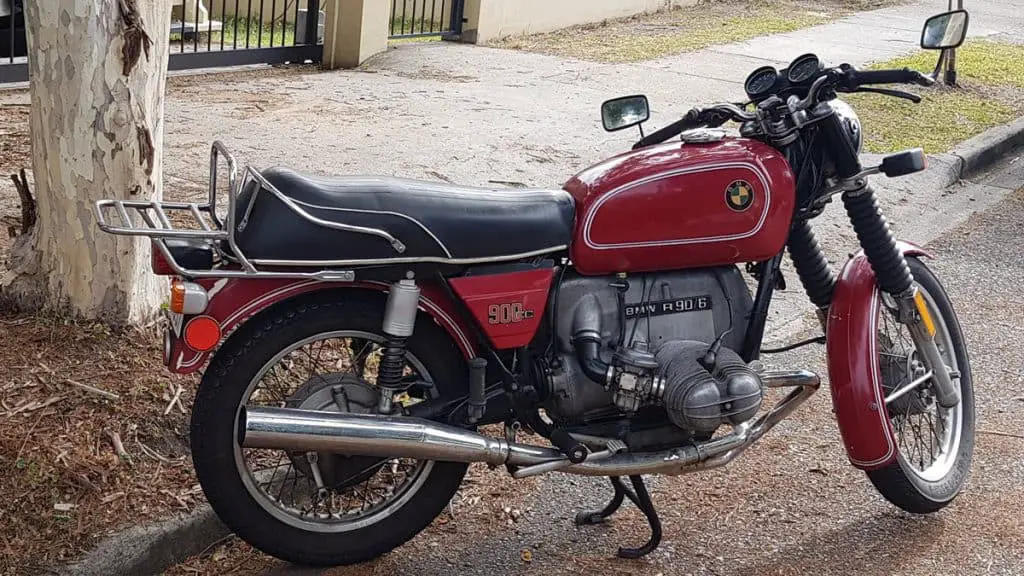Are Your New Tires Slippery? (+ How to Break Them In)
So you have invested in some fresh rubber for your motorcycle.
Time to jump aboard and hit the twisties.
Stop right there! First, you need to break in the tires.
Unless you put some miles on them, those shiny new tires will not deliver the traction or performance you need. And that means you might spill out on the first tight corner.
But how can a brand new tire be a safety hazard?
Keep reading and you’ll find out.
Why Are New Motorcycle Tires Slippery?

The slippery gloss that you see on good motorcycle tires does make them look cool. But they aren’t ready for hard riding yet.
(It’s the same with your new leathers, right?)
Honestly, the fault isn’t with the tire. Like every other piece of new equipment, it needs to be handled the right way.
So, the right amount of ‘scrubbing in’ is necessary before full-scale use.
What makes new tires slippery?
Before you ask, tire manufacturers don’t apply lubricants on the tread of new tires. The surface gloss is just the natural look of fresh rubber.
Here are the three main reasons for new tires having less traction.
- During manufacturing, a “release lubricant” is used on the sidewalls. Even though the molds are coated with non-stick materials, this is done to reduce any chance of the sidewalls sticking to the mold after curing. This helps in keeping the manufacturing numbers, company logos, and other important texts on the sidewall clear and flawless.
- Some antioxidants are also applied to the tire to prevent the chances of the material cracking up and thermal oxidation due to temperature variations. It prevents the degradation of the rubber during storage. These antioxidants can also make the tire surface slippery.
- Since the tread depth of the new tires is at the highest level, it can lead to “tread squirm”. This can lead to some extra movement while steering and the tire may feel unresponsive. This is because the new tread is hard and can’t deform or flex to grip the road surface.
In addition, there might be oils and chemicals in the new tire that can leak out during riding.
These compounds need to be leached out before you head out for some serious rising.
Beyond that, the tire surface needs to be scuffed to increase the friction with the ground.
How Do You Break in New Motorcycle Tyres?
Now apart from the chemical issues, there are other factors that determine the break-in period. This includes the rider weight, bike weight, riding style and conditions, and more.
Now, you will find two viewpoints about the right breaking-in process for motorcycle tires. While some riders will advise you to ride like hell, others will insist on being cautious and take it slowly.
While the former view can sound extreme, there are some manufacturers who claim that their tires come with a minimum break in period.
But one thing is for sure.
You need some time to get to know the new tires and understand how they perform on your bike.
This will also ensure that you understand how differently the new tires behave from the old ones. More so, when you have switched brands or the tire type.
Take It Easy
Gradual breaking of the tires is the best way to ensure optimal gripping and the best handling from them.
In reality, the actual breaking down process is super easy. All you need to do is go out for some easy gentle rides.
Check out the manufacturer’s recommendations for the break-in period. Usually, riding softly for the first 100 miles should be sufficient to prep the hardest and heaviest motorcycle tires. The lubricants and other chemicals will wear off within that period.
There are a few points that you need to keep in mind in this period.
- Drive at moderate speeds. This is not the time to hit a century.
- Avoid wet driving conditions and stick to dry roads
- Since tire traction is on the lower side, braking distances can be longer. So keep a larger gap between you and the vehicle in front.
- Since the lubricants can cause some tire slip, don’t hit hard on the brakes
- Avoid accelerating sharply and taking sharp turns
How about using sandpaper on the tire surface?
I’ve heard some riders suggest this. But trust me, riding with your weight on the bike works much better.
Heat or No Heat
The other important aspect of this phase is heating up the tire to the right temperature to leach out any oils present.
Fair enough, but isn’t heat the worst enemy of rubber?
Right you are.
Raise the temperatures of a tire anywhere between 200 to 210°F and it might start breaking down like Superman facing a lump of kryptonite.
But we aren’t heading there. Track guys heat up new tires to around 165 degrees for a few minutes before pushing them to their limits.
Now, I am not suggesting that you start investing in tire warmers or temperature guns.
Quite simply, 30 minutes of moderate to hard riding on the new tires should be good enough to bring them to the right operating temperature.

Now, veterans will also tell you to focus on a few other points during the break-in period.
- Try to plan the break-in sessions during the warmest part of the day. Avoid riding in cold and rainy conditions as it will lengthen the break-in period.
- Weaving around might seem like a good idea. But it will increase the risks of a slip during the initial phase. Racers do that only after the new tires have been pre-warmed in the garage. Ride in a straight line during the initial phase.
- Keep a close look at the tire pressure. Breaking your tires at the wrong pressure can affect long-term performance. Adjust the tire pressure as needed.
Once you start reaching the end of the 100-mile period, it’s time to push the tires harder. Now you can hit a twisty road and gradually increase the speed.
After you get a feel of the tires, you can increase the acceleration and braking forces. This will help in raising the tire temperature and transmitting the heat to the tire carcass.
Frequently Asked Questions
Are brand new tires slippery?
Yes. New tires are more slippery and offer less traction than the old ones unless they are broken in. Believe it or not, but they can be even less reliable than squared off tires! That’s why you should never take your brand new tires for longer rides without prepping them up first.
How long does it take for new tires to break in?
Manufacturers specify distances between 50 to 100 miles for breaking in new tires. During this period you adjust yourself with the tire and wear out any chemicals or oils that might be in the rubber.
What happens if you don’t break in new tires?
If you don’t break in the new tires you will not get the right amount of traction. By pushing new tires to their limits without getting used to them, you’re simply heading for a crash.






